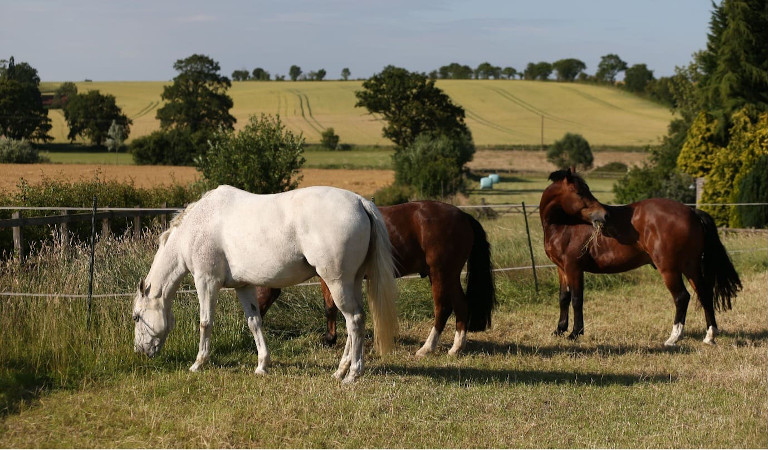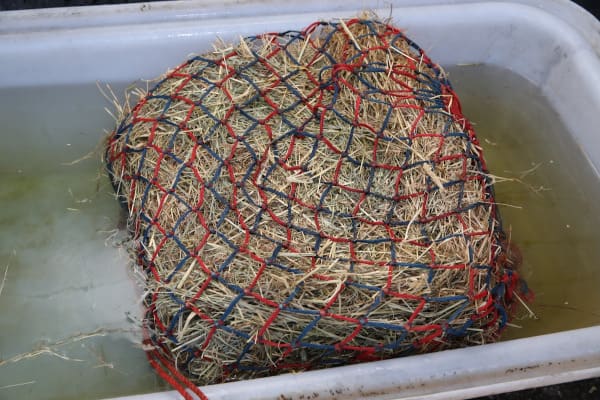Tips for managing forage intake in overweight horses & ponies
For most horses, forage is the largest source of calories in the diet - it’s also the hardest for owners to control which is one reason keeping the good doer’s waistline in check can be so challenging! The most suitable and effective ways of managing forage intake will depend on your individual horse and your yard environment. This guide includes a range of tips and advice to help get you started…
Water soluble carbohydrate (WSC)
Grass and therefore hay and haylage may be high in WSC. WSC is largely made up of simple sugars (the majority of which is sucrose, the main form of sugar in molasses and the same sugar you put in your tea!) and fructan, the ‘storage form’ of sugar in most UK grasses. Grass may contain up to 15% simple sugars and 35% WSC.
Did you know?
A 250kg pony living out at grass 24/7 may consume
- Enough energy (calories) to fuel a 500kg racehorse – equivalent to around half a bag of conditioning cubes every day
- Up to 1.9kg of simple sugar
- Almost 4.5kg of WSC

Beware of binge eating!
Turning out for short periods without a muzzle or allowing free access to grazing after removing a muzzle may lead to gorging. In fact, research has shown that ponies may consume almost 1% of their bodyweight (dry matter) in just 3 hours which may equate to two-thirds of the total daily forage allowance for those on a diet!
Watch out for frosts
Avoid turning out on sunny, frosty mornings, especially for laminitics. Grass exposed to cold temperatures in combination with bright sunlight may contain high levels of WSC.
Consider turning out at night when level of WSC may be lower
Grass can’t photosynthesise (and therefore produce sugar) without sunlight and provided it is warm enough (the temperature needs to be consistently above 5°C), fructan will be used for growth overnight.
Grazing muzzles
Grazing muzzles have been shown to reduce grass intake by approximately 80% in ponies turned out for 3 hours, but results vary between individuals so it’s important to monitor your horse’s weight, body condition and behaviour. Some horses may gain weight if only wearing a muzzle for part of their time at pasture so consider stabling or non-grass turnout for the remainder of the day. Always introduce your horse/ pony to wearing a muzzle gradually, do not leave him unsupervised until you are confident is happy to graze and drink whilst wearing it, and never leave it on 24/7. Speak to a nutritionist for more advice on using a grazing muzzle safely.
Strip grazing
Research has shown that ponies managed by strip grazing gained significantly less weight than ponies with free access to restricted grazing over a 28 period.

Hay vs haylage
Ideally feed a low WSC hay. Although haylage is not automatically higher in calories or sugar, it may be more palatable. It also has higher and more variable water content which means unless you have it analysed, it can be difficult to know how much your horse is eating on a dry matter basis (the water content doesn't count towards your horse's forage intake).
Hay soaking
Soaking hay helps to reduce the sugar (WSC) content and of course, less sugar means less calories! Just remember that losses are highly variable which means soaking doesn’t guarantee suitability for laminitics. Due to a loss of nutrients (and therefore dry matter) into the water, each haynet will contain less ‘hay’ and more water post soaking. As a guide, increase the amount of hay you soak by 20% unless you are feeding ad lib.

Consider having your forage analysed
Looks can be deceptive - even mature hay may be higher in calories and/ or WSC than you suspect. Forage analysis is the most reliable way of assessing the nutrient value of any hay/ haylage but may be a less practical option if frequently sourcing forage from different batches and/ or suppliers (although nutritional value can also vary even between bales from the same batch).
Consider replacing up to 30-50% of your horse’s hay with straw
For some horses and ponies this can be a useful of way diluting the calorie content and may mean total intake does not to be restricted so severely. Any straw fed should be introduced gradually and be of good hygienic quality. Did you know straw can be steamed before feeding?
Avoid long periods without forage
- Divide hay/haylage/straw into as many small servings as possible – if your horse doesn’t have access to grazing overnight, make the last serving as late in the evening as possible
- Try splitting rations between multiple, double-layered, small-holed haylage nets
- Consider using 'slow feeders'
How much forage should I feed?
This is a very difficult question to answer and will depend on a number of factors including how much your horse weighs, their body condition, how sensitive they are to changes in diet/ management, the nutrient content of the forage provided and whether or not they have access to grazing. Total daily intake should not be restricted to less than 1.5% of current bodyweight (dry matter) which equates to approximately 9kg of hay (11kg if you intend to soak it before feeding) for a 500kg horse without access to grazing.
Try counting your horse’s droppings
Counting droppings can be a useful way of monitoring forage intake, especially if your horse has access to grazing and/ or you don’t know how much he weighs. If your horse is overweight, aim to reduce the number of droppings by a third initially and never by more than half.
For specific advice on managing your horse's forage intake contact the Care-Line.



